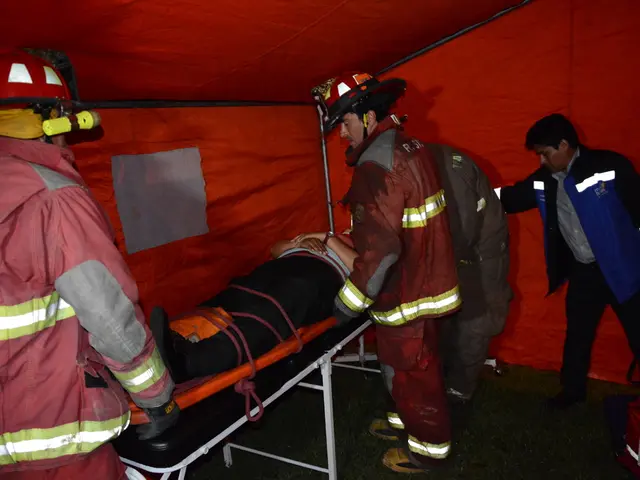A Fresh Approach to Avoiding Runner's Woopsies
Completing these pre-run flexibility exercises might assist in preventing potential injuries during your jog.
Hey there, fitness enthusiasts! Having a troubled history of ankle twists, knee strains, and hip aches during your runs? Fret not, because we've got your back - and your legs - with a nifty mobility workout designed specifically for runners!
Not warming up before running is like jumping into a cold pool without sneaking in a quick dip in the shower first. The consequences? You'll be left cringing in pain from those nasty strains, pulls, or tears that could take days, weeks, or even months to heal. Better save some time (and sanity) by warming up, buddy!
W. Zach Smith, a physical therapist from HIDEF Physical Therapy, has got your back with this quick-and-easy mobility workout you can do at home before your run. So, what's stopping you? Lace up your sneakers and let's get moving!
Why Runners Need This Workout
"These drills are gold for runners," Smith shares, "because it's a simple, easy-to-do routine that covers all the essential joints involved in running. Many a runner has gone straight out the door with no stretching, and the first mile or so, they feel all tight and just aren't moving as they want. This short mobility routine will help not only improve their running but also set the foundation for a consistent, long-term mobility routine, which is crucial for sustained fitness."
Time for Action: The Mobility Drills
Dynamic Stretching Warm-Up (5-10 minutes)
Dynamic stretching is an essential part of pre-run preparations as it readies your body, improves your range of motion, and reduces stiffness. Here's a sample routine:
- Leg Swings: Stand with your feet hip-width apart and swing one leg forward and backward, then switch to the other leg. Continue for about 30 seconds per leg.
- Knee to Chest: Stand with your feet together and bring one knee up to your chest, holding for a second before lowering. Alternate legs for about 30 seconds.
- Heel Walks: Walk on your heels with your toes lifted, focusing on keeping your knees straight. Walk for around 30 seconds.
- High Knees: Run in place, bringing one knee up toward your chest while keeping the other foot on the ground. Alternate legs for about 30 seconds.
- Calf Raises: Stand on the edge of a step or curb with your heels hanging off. Slowly raise up onto your tiptoes and then lower back down. Repeat for about 30 seconds.
Mobility Drills (5 minutes)
In addition to dynamic stretches, adding these mobility drills can work magic for improving flexibility and preventing injuries:
- Ankle Rotations: Sit on the floor with your legs straight out in front of you. Lift one foot off the ground and draw circles with your ankle, first clockwise and then counterclockwise. Repeat with the other foot.
- Hip Circles: Stand with your feet together and your hands on your hips. Move your hips in a large circle, first clockwise and then counterclockwise. Repeat for about 30 seconds each way.
- Toe Stretch: Sit on the floor with your legs straight out in front of you. Lift your toes up as high as you can and then lower them back down. Repeat for about 30 seconds.
Foot Exercises (5 minutes)
Don't forget about your feet! They are the unsung heroes of every run. Strengthening and stretching your feet can help prevent injuries:
- Toe Scrunch: Use a small towel placed on the floor. Using your toes, scrunch the towel toward you and then release. Repeat for about 30 seconds.
- Toe Tap Balance: Stand on one foot and tap the other foot on the ground in front of you. Switch feet and repeat. This exercise helps improve balance and coordination.
A Runner's Final Pre-Run Routine
After completing these exercises, be sure to hydrate and mentally prepare for your run. A warmed-up body means you reduce the risk of injury and performing better during your run.
Bonus Tips for Injury Prevention
- Invest in Quality Running Shoes: "For new runners, I always suggest getting fitted for good running shoes," says Smith. "Ensure you change your shoes out as recommended by the manufacturer or running app like Strava. This is crucial for preventing injuries."
- Gradual Approach (Ramp-Up): "Aside from that, the most important part of starting any new activity is the ramp-up," says Smith. "The rapid way people get overuse injuries quickly is to ramp up too fast. Running takes time for the body to adapt to the impact forces. The forces on your legs are two to three times your bodyweight while jogging."
- Get Professional Help: "If you hurt your ankle or any other part of your body during a run, always consult a physical therapist for assessment and guidance," advises Smith. "Pain or swelling in your ankle should be heeded with caution, and rest is advised to avoid re-injury and long-term problems."
Get ready to hit the pavement, gussies—you're now armed and ready to evade those pesky runner's injuries. Happy trails!
- It's advantageous for those interested in health-and-wellness to incorporate science-backed mobility workouts like the one provided by W. Zach Smith from HIDEF Physical Therapy, as these routines target essential joints involved in running, thereby improving running efficiency and preventing injuries.
- Alongside sports-related activities, prioritizing fitness-and-exercise involves more than just workouts; it's essential to focus on the importance of pre-run warm-ups and cool-downs, dynamic stretching, mobility exercises, and foot exercises, which can significantly minimize the risk of runner's injuries and promote overall wellbeing.








